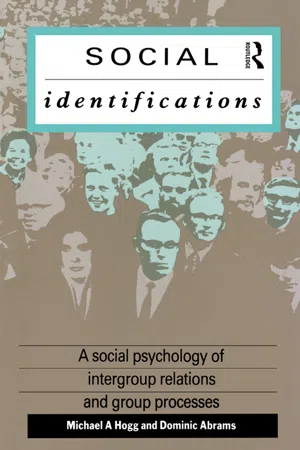Psychology
Social Psychology
Social psychology is the study of how individuals' thoughts, feelings, and behaviors are influenced by the actual, imagined, or implied presence of others. It explores topics such as social influence, group dynamics, prejudice, and interpersonal relationships. This field examines the impact of social factors on individual behavior and cognition.
Written by Perlego with AI-assistance
Related key terms
12 Key excerpts on "Social Psychology"
- eBook - ePub
Essentials of Social Psychology
An Indian Perspective
- Shubhra Mangal, Shashi Mangal(Authors)
- 2022(Publication Date)
- Routledge(Publisher)
- It tells us that our thoughts, feelings and actions are influenced with the interactions and presence of others and vice versa. Proceeding further, it acquaints us with the way these are influenced in the presence of others in one or the other social situations. In other words, thus, Social Psychology may be found to look at human behavior as influenced by other people and the social context in which this occurs.
- For influencing and affecting our feelings, thoughts and actions, the actual presence of others is not essential. It can happen also with their imagined and implied presence such as when watching television or following internalized cultural norms.
- Social Psychology provides a scientific explanation of what, how and why people think, feel and behave the way they do with others, influence them and have interactions and relationships with them in one or the other social situations.
- It helps us in understanding and explaining the manner in which our thoughts, feelings and actions influence others or get influenced in the presence/interactions with others. Apart from the ongoing behavior of others, social experiences preserved in our memory, and the attitudes formed out of these experiences, and physical factors also influence our behavior towards others.
Social PsychologyAn applied branch of the subject psychology that deals with the scientific study of the behavior of individuals in a social context enabling us to get an explanation of the nature and causes of their thoughts, feelings and behaving with others in one or the other social situations.- In this way, what is available in the form of social as well as other variables to us in our social environment at one or the other time, proves quite significant in influencing our bent of mind (in terms of our attitudes, perceptions and motives) and our actions and behavior at that time and also in future in the similar encounters. By highlighting all such things, Social Psychology tries to bring out all the factors that lead us to behave in a given way in the presence of others, and look at the conditions under which certain types of behavior/actions and feelings occur.
- eBook - ePub
- Ann L. Weber, Joseph Johnson(Authors)
- 2011(Publication Date)
- Collins Reference(Publisher)
CHAPTER 16Social Psychology
S ocial psychology is the field of psychology that studies the social influences on the individual. It has common interests with both sociology, which studies groups, and personality psychology, which studies individual differences. In this chapter, we first examine the effects of social settings on the individual. Then, we survey the major topical areas comprising Social Psychology: social cognition, involving cognitive processes like perception and thought that concern social experiences; attitudes, a major area of research within Social Psychology; and social influences and interactions, including interpersonal relationships and group processes.SOCIAL EFFECTS ON THE INDIVIDUALLike other fields of psychology, Social Psychology studies individual thought and behavior. However, other fields study these phenomena by examining internal structures or processes (for example, the nervous system, learning, perception) or individual characteristics and developmental experiences (for example, personality theory or developmental processes). In contrast with these internal or personal perspectives on behavior, Social Psychology adopts a situational perspective on behavior and thought. In other words, whereas other fields are more likely to ask what is going on inside the person, social psychologists ask what is going on around the person.Self-PerceptionAccording to social psychologist Daryl Bem, people come to understand themselves by making inferences based on observations of their own behavior. This is the reverse of the common-sense notion that we know ourselves, and then act in such a way as to be true to ourselves. An example of the self-perception process would be figuring out how to answer a question about your own political values. If you have not already formulated an answer to the question, you will have to consider what your position is on several issues, and then draw a conclusion about what your basic position—for example, political liberal or conservative—must be. In a sense, you observe your own behavior by reviewing your positions and remembering how you have voted. Then you make an inference about the connective causes of your behaviors. You thereby arrive at a perception of yourself. - eBook - ePub
Social Identifications
A Social Psychology of Intergroup Relations and Group Processes
- Dominic Abrams, Michael A. Hogg(Authors)
- 2006(Publication Date)
- Routledge(Publisher)
Our portrait, then, of ‘good’ Social Psychology characterizes it as an empirical science which adopts an array of methods to discover the mental processes involved in the complex dialectical relationship between stimuli and human behaviour. But what of ‘social’? What does the term mean? How has it been interpreted in the past? Herein lies the debate of principle concern to us. What is social about Social Psychology?THE ‘SOCIAL’ IN Social Psychology
Credit for conducting the first Social Psychology experiment is traditionally given to Triplett, who investigated the effect of the physical presence of others on the performance of various tasks, such as winding in fishing line or peddling a bicycle (Triplett 1898), and thus initiated a continuing tradition of social psychological research into the social facilitatory or inhibitory effect on behaviour of the mere physical presence of others (see Ch. 6 below, and also reviews by Guerin 1986; Paulus 1983; Sanders 1981). Perhaps, then, psychology is social to the extent that it examines the way individual behaviour is affected by the physical presence of others. It is not surprising to learn that a large proportion of Social Psychology is concerned with face-to-face encounters between small numbers of individuals, for example, research into non-verbal communication (Argyle 1973; Scherer and Ekman 1982), group decision-making and small-group dynamics (Golembiewski 1962; Shaw 1981), conformity and social influence (Allen 1965, 1975) see also Ch. 5 and 8 below). Furthermore, since, according to James, 73 per cent of naturally formed groups are dyads (James 1953), much of Social Psychology focuses on the dyad as the ultimate or prototypical unit of social psychological analysis (e.g. Kelley and Thibaut 1978; see also Ch. 5 below).This sort of definition cannot, however, encompass another large portion of social psychological concerns, for example research into values, attitudes, opinions, and beliefs (e.g. Rokeach 1973; Cooper and Croyle 1984) and their change (see Cialdini, Petty, and Cacioppo 1981), and also into stereotypes (see Ashmore and Del Boca 1981) and social representations (Farr and Moscovici 1984). What is needed is a broader definition such as perhaps Gordon Allport’s description of Social Psychology as ‘an attempt to understand and explain how the thought, feeling, and behaviour of individuals are influenced by the actual, imagined, or implied presence of others’ (Allport 1968:3). Attitudes are social psychological because they orient people with respect to other people, events, and/or physical objects. Without other people, attitudes would very likely not exist at all. At very least they depend on language, and language as a consensual means of communication between human beings cannot exist without there being other human beings (see Ch. 9 below). Attitudes can be carried away from face-to-face encounters in the mind of the individual, and thus there is a sense in which they represent the implied presence - eBook - ePub
- Allan Tasman, Jerald Kay, Jeffrey A. Lieberman, Michael B. First, Mario Maj, Allan Tasman, Jerald Kay, Jeffrey A. Lieberman, Michael B. First, Mario Maj(Authors)
- 2011(Publication Date)
- Wiley(Publisher)
CHAPTER 27 Social PsychologyHoward Tennen1Paulette M. Gillig21 Department of Psychiatry, University of Connecticut Health Center, Farmington, CT, USA2 Department of Psychiatry, Wright State University Boonshoft School of Medicine, Dayton, OH, USAIntroductionBy training, interest, and definition as a medical specialty, the field of psychiatry emphasizes the medical treatment of psychopathology (illnesses or disorders) of individual patients (children and adults). Social Psychology scientifically studies, often by experimentation, the way in which behaviors and cognitions of persons usually without preexisting psychopathology are shaped by the social environment and influenced by the real or imagined presence of other people (Allport 1954). The social psychologist is not so much focused on individual differences, but rather in determining scientifically the general principles that determine how social influences affect the behaviors of all people. This chapter is not meant to cover exhaustively the implications of the Social Psychology literature for clinical psychiatry, and due to space limitations it is beyond the scope of this chapter to survey the vast field of Social Psychology.In this chapter, we focus mainly on persons without major mental disorders, in order to illustrate to the reader some of the fundamental principles involved in interpersonal behavior, the formation of the “self” via feedback from other people, and some of the fundamental principles involved in interpersonal behavior. In the chapter 26, the authors describe the principles of normal cognitive processes, and illustrates how disordered cognitive processing can distort an individual’s ability to follow the “rules” of interpersonal functioning that are illustrated in this chapter, including the loss of ability to detect, interpret, and calculate the relative benefits and costs of chosen behaviors. - eBook - ePub
Principles of Social Psychology
Third Edition
- Kelly G. Shaver(Author)
- 2015(Publication Date)
- Psychology Press(Publisher)
Chapter OneSocial Psychology: Accounting for Social BehaviorContents
WHAT KIND OF EXPLANATION? Criteria for Scientific Explanation Implicit Theories of Social Psychology Counterintuitive Findings: A Study of Obedience OBSERVATION AND THEORY Hypothetical Constructs Study of Ongoing Social Processes The Social Psychology of Research Theory and Application CONSTRUCTING A DEFINITION OF Social Psychology Level of Analysis A Formal Definition PLAN OF THE BOOK Fifty Years of Experimental Social Psychology Cognition and Motivation Overview Methodology Section 1: Intrapersonal Processes Section 2: Individual Needs and Social Exchange Section 3: Elements of the Social Context SUGGESTED ADDITIONAL READINGSPreview
"Opposites attract."A relatively recent addition to the scientific study of human behavior, Social Psychology was established as an independent discipline only in the late 1930s. Defined as the "scientific study of the personal and situational factors that affect individual social behavior," Social Psychology considers the cognitive and motivational processes that affect interpersonal behavior in a larger social context. Social psychologists observe human behavior, construct theories to explain those human actions, and test the validity of their theories in research. Although observations of social activities can be a rich source of hypotheses for study, personal experience alone cannot substitute for the understanding that can be achieved through scientific methods.This "explanation" for romantic attachment is one of the staples of our popular wisdom about social behavior. Romantic attraction is so fundamental a human phenomenon that few people will be likely to claim they have never been "in love," at least once. From a teenager's temporary infatuation to an elderly couple's celebration of 50 years of marriage, romantic involvements provide us with many of our warmest memories. Unfortunately, attraction can also lead to tragedy: half of the couples who marry in America today will eventually be divorced; some 30% of American couples will report an episode of physical violence occurring at least once in their marriage (Straus, Gelles, & Steinmetz, 1980); estranged lovers or spouses are involved in a large fraction of the murders committed in a year. If a principle as concise as "opposites attract" could explain not only the successes, but also the failures, in romantic relationships, it would truly be the powerful explanatory tool suggested by its longevity in everyday accounts of interaction. - eBook - ePub
- Miles Hewstone, Wolfgang Stroebe, Miles Hewstone, Wolfgang Stroebe(Authors)
- 2021(Publication Date)
- BPS Blackwell(Publisher)
As the chapters in this volume illustrate, they have contributed importantly to the development of applied areas ranging from health psychology, to organizational psychology (see Chapters 12 and 13), to resolving intergroup conflict (see Chapter 14). In the absence of systematic and controlled social psychological research in most areas, F. Allport (1924) had to rely heavily on speculation in his ambitious road map for Social Psychology as an empirical science. We hope that the readers of this textbook will appreciate the progress social psychologists have made in less than a century in replacing speculation with theory‐guided empirical research. CHAPTER SUMMARY How can Social Psychology be defined? Social Psychology is often defined as the scientific attempt to understand and explain how thoughts, feelings and behaviours of individuals are influenced by the actual, imagined or implied presence of other human beings. How does Social Psychology differ from other psychological disciplines? One of the main differences is the focus on the impact of the characteristics of the social situation on thoughts and behaviour of individuals - eBook - ePub
- Vivien Burr(Author)
- 2005(Publication Date)
- Psychology Press(Publisher)
Chapter 6 The person in social psychologyWhere’s the ‘social’ in Social Psychology?
IN THIS BOOK I HAVE DISCUSSED a variety of perspectives and theories that may be referred to as Social Psychology and, in each case, I have asked what it is about them that is social. The answers to this question are also very varied, and have important implications for what can be said about the central concern of the book and of this final chapter – the nature of the person in Social Psychology. For the purposes of drawing out the relevant themes I have chosen to contrast the current individualistic and intrapsychic approach of social cognition with a variety of others that may be thought of as interpersonal, societal or a mixture of both.The intrapsychic model: social cognition
It may be argued that the predominant psychological Social Psychology with which psychologists are familiar has become increasingly individualistic and intrapsychic in orientation in recent times. In the past it has often been concerned to identify the impact of the presence or conduct of other people upon the functioning and behaviour of individuals, for example in the social facilitation experiments of Triplett (1898) which are regularly quoted as being among the very first experiments in Social Psychology. Much research on phenomena such as obedience, conformity, bystander behaviour, group decision-making and interpersonal attraction can be thought of as fitting this picture. The social here is conceived as a set of variables relating to other people and their conduct that may influence a pre-existing, self-contained individual. Other research and theory, particularly that which focuses upon dynamics within and between groups, has sometimes gone beyond this position to suggest that a person’s location within social groups is an important source of identity and self-esteem. The role of the social here is not simply one of impacting upon a pre-existing individual but in some way helping to create - eBook - ePub
- Miles Hewstone, Wolfgang Stroebe, Klaus Jonas, Miles Hewstone, Wolfgang Stroebe, Klaus Jonas(Authors)
- 2016(Publication Date)
- BPS Blackwell(Publisher)
Even though social psychologists are mainly interested in studying how attitudes change in response to social influence attempts (see Chapters 7 and 8), they also use attitudes to predict individual behaviour (see Chapter 6). Furthermore, within Social Psychology, researchers have often been interested in studying individual difference variables, such as the degree to which individuals are prone to prejudice and susceptible to Fascist ideologies (‘authoritarianism’; Adorno et al., 1950; see Chapter 14), or the degree to which individuals are oriented to situational cues or reactions of others (‘self-monitoring’; Snyder, 1974). Since there is a great deal of agreement that individual behaviour is influenced by personality traits (see Chapter 9 on aggression) as well as the social context, the two fields of personality psychology and Social Psychology are, in fact, difficult to separate. It is therefore not surprising that the leading social psychological journal is the Journal of Personality and Social Psychology, and that most American social psychologists are members of the Society of Personality and Social Psychology. However, there are subtle differences in focus. Social psychologists are typically interested in personality variables as moderators. They look for the extent to which the impact of an independent variable on a dependent variable is qualified by, or depends on, the level of an individual’s score on a personality measure. For example, there is a higher correlation between attitudes and behaviour for ‘low’ than for ‘high’ self-monitors (Snyder & Kendzierski, 1982). Many of the chapters in this volume refer to such personality influences on social behaviour. Social psychologists also tend to emphasize that the impact of personality variables on social behaviour is weaker in ‘strong’ compared to ‘weak’ social situations (Mischel, 1977) - eBook - ePub
Consistency in Cognitive Social Behaviour
An introduction to social psychology
- C.J. Mower White(Author)
- 2015(Publication Date)
- Psychology Press(Publisher)
Chapter 5 will consider how these processes can be extended and affected by group membership: that is, how decisions about attitudes, attribution and attraction, are influenced by a person being part of a group of people who may be similar to himself.2 Consistency in cognitive Social PsychologyWhen one considers these topics, there appears to be a simple general principle which has been used by social psychologists to explain them all. This is the notion of consistency. It seems that laymen and professional social psychologists alike expect that the different attitudes a person holds will be consistent with each other, that his attitudes will in turn be consistent with his behaviour, that he may be described by compatible or non-contradictory personality characteristics, and that he will be attracted to others who hold values consistent with his own. Consistency is probably an over-used word in Social Psychology, and may be taken to mean ‘compatible’, ‘similar’, ‘non-contradictory’, ‘conforming’, ‘inagreement’, or ‘congruous’. These uses will be followed here.There are several points to be made about the notion of consistency. As already mentioned it has been applied to a number of areas in Social Psychology and in personality theory. For instance, it sometimes appears that there are a number of personality traits which are similar in meaning and which are often found clustered together. For example, it might be that individuals who are shy are also timid and cautious, whereas those who are extroverted may be neighbourly and chatty. An important point about the idea of consistent clusters of traits (see Hampson, 1982), and about the notion of consistency generally, is that, although the concept of consistency may be based on fact, it is a notion which is exaggerated by the layman in his attempts to interpret and predict other people’s behaviour; that is to say, it may be true that a person’s attitudes are sometimes consistent with his behaviour, but it is likely that as laymen or as psychologists we expect this consistency more often than it is actually present. - eBook - ePub
- R. F. Kidd, M. J. Saks(Authors)
- 2014(Publication Date)
- Psychology Press(Publisher)
All of us who are interested in promoting applied Social Psychology have reason to be concerned because the implicit lesson that Social Psychology students are exposed to is that intellectual involvement is encouraged, active involvement is not. Too many aspects of our graduate programs may lead students to conclude that designing, implementing, and evaluating changes in social policies is not the surest pathway to professional success in Social Psychology. It is not necessary for Social Psychology to lose its scientific mind to have a humanistic heart, but it often seems that the choice is cast in these terms. For the health of the discipline as a whole we need to create a better balance between the heart and the mind, to allow more of the blood of humanism to course through the body of knowledge represented by Social Psychology. The time has arrived for a mature integration of both sides of Social Psychology’s personality into a deeper synthesis than the separate pursuit of each is likely to produce.The Use of Intrapersonal and Contextual Theories in Social Psychology Daniel Stokols(University of California, Irvine)Environmental psychology is one of the newer, so-called “applied” areas of research that has captured the attention of social psychologists in recent years. The literature in environmental psychology, pertaining broadly to the relationship between the sociophysical environment and behavior, has expanded rapidly during the past decade (cf. Altman, 1976; Craik, 1973; Proshansky, Ittelson, & Rivlin, 1976; Stokols, 1978). The appearance of textbooks (e.g., Bell, Fisher, & Loomis, 1978; Heimstra & McFarling, 1978; Ittelson, Proshansky, Rivlin, & Winkel, 1974), multiple-volume series focusing on theoretical and empirical advances (Altman & Wohlwill, 1976; Baum, Singer, & Valins, 1978), as well as the establishment of new journals (Lee, 1976; Thompson, 1977; Winkel, 1969), and a formal APA Division (34) of Population and Environmental Psychology, all attest to the rapid growth and current vitality of the environmental-and-behavior field.Observers from within the mainstream of Social Psychology may still be wondering what all the commotion is about. After all, psychologists have been studying the effects of the environment on behavior at least since the days of Watson (1913). And among social psychologists, few would question Lewin’s (1935) famous equation, Behavior = f (Person and Environment). Thus, many researchers view the concerns of environmental psychology as redundant with those of more traditional areas within psychology, and regard the emergence of an environmentalist research focus as either a clever adaptation to current funding priorities and a tight job market (both of which encourage societally “relevant” research), or as a reflection of the more noble desire among psychologists to participate in the solution of urgent community problems such a environmental degradation, world population growth, and the depletion of natural resources.1 - eBook - ePub
Social Psychology
Core Concepts and Emerging Trends
- Daniel W. Barrett(Author)
- 2015(Publication Date)
- SAGE Publications, Inc(Publisher)
I suspect that you found it hard to select just one. Social psychologists are with you, and one of Social Psychology’s most appealing and important features is that it considers multiple explanations for any given behavior. Social phenomena are not so simple that they can be fully explained by any single factor, and consequently, Social Psychology has incorporated a number of approaches to understanding them.In fact, several of the most important developments in Social Psychology since the middle of last century reflect these different approaches to explaining social behavior. These different perspectives or levels of analysis complement each other, allowing us to develop a more holistic understanding of social phenomena (Bruner, 1990; De Houwer & Moors, 2015). These three levels of explanation vary in scope and method and are the (see Figure 1.3 )- evolutionary level, which emphasizes the genetic history of the human race;
- contextual level, which looks at group pressures, societal influences, and cultural background;
- individual level, which asks about a person’s own learning history, experiences, and cognitive processes.
Evolutionary Factors
The early American social psychologist McDougall, influenced by Charles Darwin’s theory of evolution, placed natural instincts at the forefront of his explanations for social behavior. McDougall’s instinct-based approach quickly fell out of favor as a primary cause of human behavior and was replaced with a more externally focused, behaviorist perspective (Jackson, 1988). As a result, for several decades little attention was devoted to evolutionary or biological influences on social behavior. However, since the 1990s social psychologists have come a long way toward remedying this oversight, and today the study of biological influences on social psychological processes has been integrated into the mainstream of our science (Duntley & Buss, 2008; Kenrick & Cohen, 2012). - eBook - ePub
Introduction to Psychological Science
Integrating Behavioral, Neuroscience and Evolutionary Perspectives
- William J. Ray(Author)
- 2021(Publication Date)
- Routledge(Publisher)
More than 70 years ago, the social psychologist Solomon Asch noted that not only do we develop quick impressions of others, but that it is also involuntary (Asch, 1946). All of this takes place out of our awareness through a complex set of determinations in our brain (see Kang & Bodenhausen, 2015 for an overview). Not only does our brain influence social interactions, but our social relations influence how our brain develops (Falk & Bassett, 2017).Given the long history of humans interacting with other humans, it is not surprising that there is great complexity in the manner in which we interact with one another. We treat relatives differently than others. We treat those who look like us differently than those who do not. We would choose to save a child in a burning building as opposed to an older adult. Overall, what this means is that there is no simple way of describing our social relationships with one another. However, we can view this complexity within larger categories of behavior and experience.This chapter emphasizes social relationships, especially those such as cooperation and competition, and the rules that underlie our social relationships. Not only do we make social evaluations, but we also make decisions concerning when not to act or share information with others. This requires a type of inhibition on our part. Further, in the chapter you will learn about what factors lead us to do what others tell us as well as how we evaluate others in potential social roles. This is one hallmark of Social Psychology. That is, Social Psychology has traditionally focused on the situation and the way in which changing the situation influences how we form attitudes and interact with others.It is clear that a variety of abilities and developmental processes of humans support a high level of social interaction for an extended period of time. We remember relationships we grew up with and this influences our adult relationships. We tend to use attachment styles similar to those we experienced as children. Additionally, humans have the ability to use language with ease, which fosters social interactions even at long distances. We are particularly sensitive to emotional cues that deepen social interactions such as emotional faces. We even include emotional symbols in our text messages to one another (J).
Index pages curate the most relevant extracts from our library of academic textbooks. They’ve been created using an in-house natural language model (NLM), each adding context and meaning to key research topics.











